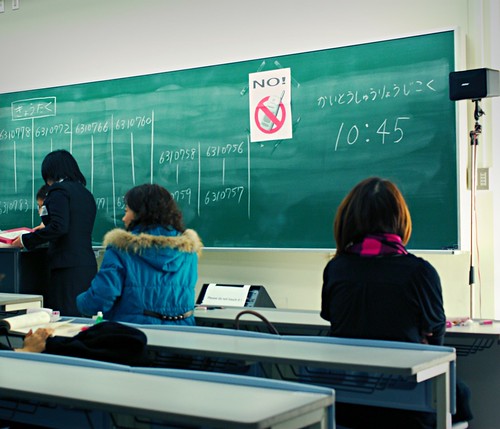Sometimes it's hard to know where to start when it comes to preparing for the Japanese Language Proficiency Test, how is your preparation going? There is a lot you can do to make sure you are well prepared for the test. It's also important to remember the test is not the ultimate goal, communication in Japanese is.

Testing by JanneM, on Flickr | CC BY-NC-SA 2.0
The JLPT can be a real motivator to learn the language and get exposure to a wider vocabulary, even so it's a very one-sided way to develop your language skills. Having the 10,000 word vocabulary expected of you to pass level 1 is only a fraction of what the average high school graduate learns, and that is only a fraction of the total number of words in the language. This Japanese dictionary has over 500,000 entries (JP).
Get out there and have fun, there is life after exam hell. Here is a simple review of the JLPT topics I have covered on this blog.
Review your test preparation strategy.
A while ago I covered things I did to ensure success at the JLPT, an idea which developed further this year into an eduFire class and series of blog posts. September this year, in How To Ace The Japanese Language Proficiency Test At Any Level, I delivered five essential techniques for doing well on test day.
- Take the first step to Ace the JLPT - Know yourself
- Take the second step to Ace the JLPT - Know the terrain
- Take the third step to Ace the JLPT - Train your weaknesses
- Take the fourth step to Ace the JLPT - Race your strengths
- Take the fifth step to Ace the JLPT - Stay fresh
Use the right tools.
Choosing the best Japanese dictionary when you start out is very important, but as your Japanese improves you'll want to make sure you're using a monolingual dictionary. Here are 3 Good Reasons to Use a Monolingual Japanese Dictionary:
- Monolingual dictionaries contain authentic grammar and vocabulary.
- Monolingual dictionaries reinforce vocabulary and make it easy to discover more.
- Monolingual dictionaries give clearer clues to context.
There is also plenty of software that can help you master Japanese. One of my favourite is Nihongoup, you'll find a full review of this game-like tool for learning the written Japanese language. I also encourage people to learn how to read japanese kanji with Read The Kanji a spaced repetition service.
You can really start to get the most out of a spaced repetition service when you can build your and collaborate on other people's lists. Smart.fm does this really well, they might be going through a few changes at the moment but I'm looking forward to what they come up with. I've invested a lot of time and energy into creating a bunch of lists to help you learn Japanese, so I really hope they sort things out soon.
Learn Japanese with the right people.
There is nothing like finding the right people to share your enthusiasm for learning Japanese with. I go into much greater detail about how to prepare for the test on my newsletter. In the meantime check out past posts on preparing for the JLPT, including an hour of exam preparation training on eduFire, and the series 'Ace The Japanese Language Proficiency Test At Any Level'.
- Take the first step to Ace the JLPT - Know yourself
- Take the second step to Ace the JLPT - Know the terrain
- Take the third step to Ace the JLPT - Train your weaknesses
- Take the fourth step to Ace the JLPT - Race your strengths
- Take the fifth step to Ace the JLPT - Stay fresh
 5 Steps To Ace The Japanese Language Proficiency Test At Any Level is a Free Online Seminar at eduFire
5 Steps To Ace The Japanese Language Proficiency Test At Any Level is a Free Online Seminar at eduFireHow will approach your JLPT study in 2010?
Are you taking the test this year? If you've done it before, do you plan to do things differently this time around?


